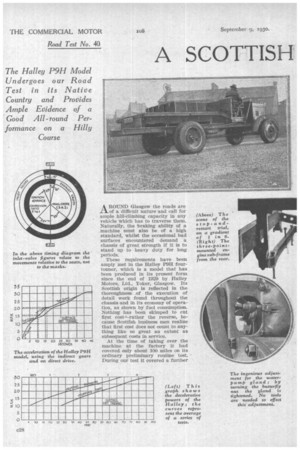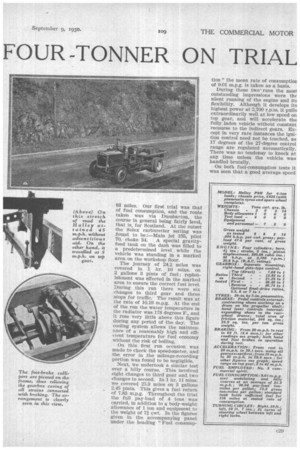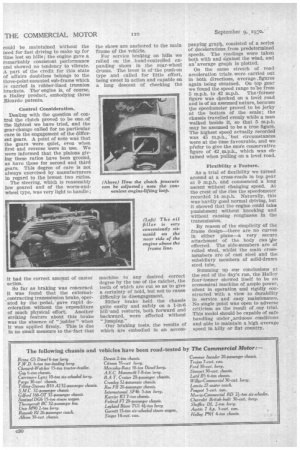A SCOTTISH
Page 50

Page 51

Page 52

If you've noticed an error in this article please click here to report it so we can fix it.
FOUR -TONNER ON TRIAL
The Halley P9H Model Undergoes our Road Test in its Native Country and Provides Ample Evidence of a Good All-round Performance on a Hilly Course
A ROUND Glasgow the roads are _Clot a difficult nature and call for ample hill-climbing capacity in any vehicle which has to traverse them. Naturally, the braking ability of a machine must also be of a high standard, whilst the occasional bad surfaces encountered demand a chassis of great strength if it is to stand up to heavy duty for long periods.
These requirements have been amply met in the Halley PDT( fourtonner, which is a model that has been produced in its present form since the end of 1929 by Halley Motors, Ltd., Yoker, Glasgow. Its Scottish origin is reflected in the thoroughness of the execution of detail work found throughout the chassis and in its economy of operation, as shown by fuel consumption. Nothing has been skimped to cut first cost:—rather the reverse, because Scottish business men realize that first cost does not count to anything like so great an extent as subsequent costs in service.
At the time of taking over the machine at the factory it had covered only about 100 miles on its ordinary preliminary routine test. During our test it covered a further 83 miles. Our first trial was that of fuel consumption, and the route taken was via Dumbarton, the course in general being fairly level, that is, for Scotland. At the outset the Solex carburetter setting was found to be :—Main jet 155, pilot
70, choke 34. A special gravityfeed tank on the dash was filled to a predetermined level while the vehicle was standing in a marked area on the workshop floor.
The journey of 24.2 miles was covered in 1 hr. 10 mini. on 2 gallons 3 pints of fuel; replenishment was effected in the marked area to ensure the correct fuel level. During this run there were six changes to third gear and three stops for traffic. The result was at the rate of 10.19 m.p.g. At the end of the run the water temperature in the radiator was 178 degrees F., and it rose very little above this figure during any period of the day. The cooling system allows the maintenance of a reasonably high and efficient temperature for fuel economy without the risk of boiling.
On this first run occasion was made to check the speedometer, and the error in the mileage-recording portion was found to be negligible.
Next, we undertook a similar test over a hilly course. This involved eight changes to third gear and, two changes to second. In 1 hr. 11 nuns. we covered 25.9 miles on 3 gallons 2,45 pints. This gives a fuel return of 7.83 m.p.g. Throughout the trial the full pay-load of 4 tons was carried, in addition to a body-weight allowance of 1 ton and equipment to the weight of 71 cwt. In the figures given in the accompanying panel under the heading "Fuel consump
tion " the mean rate of consumption of 9.01 m.p.g. is taken as a basis.
During these two' runs the most outstanding impressions were the silent running of the engine and its flexibility. Although it develops its highest power at 2,700 r.p.m. it pulls extraordinarily well at low speed on top gear, and will accelerate the fully, laden vehicle without constant recourse to the indirect gears. Except in very rare instances the ignition control need not be touched, as 17 degrees of the 27-degree control range are regulated automatically. There was no tendency to knock at any time unless the vehicle was handled brutally.
On both fuel-consumption tests it was seen that a good average speed
could be maintained without the need for fast driving to make up for time lost on hills ; the engine gave a remarkably consistent performance and showed no tendency to vibrate. A part of the credit for this state of affairs doubtless belongs to the three-point-mounted sub-frame which is carried in rubber-lined trunnion brackets. Theengine is, of course, a Halley product, embodying three Ricardo patents.
Control Consideration.
Dealing with the question of control the clutch proved to be one,of the lightest we have tried, and the gear-change called for no particular care in the engagement of the different gears. A point of note was that the gears were quiet, even when first and reverse were in use. We were informed that the pinions giving these ratios have been ground, as have those for second and third gears. This degree of care is not always exercised by manufacturers in regard to the lowest two ratios.
The steering, which is reasonably low geared and of the worm-andwheel type, was very light to handle; It had the correct amount of castor action.
So far as braking was concerned it was found that the external • contracting transmission brake, operated by the pedal, 'gave rapid deceleration without the expenditure of much physical effort. Another striking feature about this brake was the absence of " judder " when it was applied firmly. This is due in no small measure to the.fact that the shoes are ancboted to the main frame of the vehiele.
For service braking on hills we relied on the hand-controlled expanding shoes in the rear-wheel drums. The lever is of' the push-on type and called for little effort, being sweet in action and capable on a long descent of checking the machine to any desired correct degree by the use of the ratchet, the teeth of which are cut so as to give a certainty of hold, but not to cause difficulty in disengagement.
Either brake held the chassis quite easily and safely on a 1-in-G hill and restarts, both forward and backward, were effected without "Jumping."
Our braking tests, the results of which are embodied in an accom panying graph, consisted of a series of .decelerations .from predetermined speeds. The readings were taken both with and igainst the wind, and an average graph is plotted.
On the same stretch of road acceleration trials, were carried out in bOth directions, average .figures again being obtained. On top gear we found the speed range to 'be from 5 m.p.h. to .42 m.p.h. The 'former figure was checked on a level road and is of an assumed nature, because the speedometer proved to be jerky at the bottom of the scale ; the chassis travelled evenly while a man walked beside it, so that 5 m.p.h. may be assumed to be a true figure. The highest speed actually recorded was 45 m.p.h., 'but circumstances were at the• time• favourable, and we prefer to give the more conservative figure of 42 )p.p.h., which was obtained when pulling on a level road.
Flexibility a Feature.
As a trial of flexibility we turned around at a cross-roads in top gear at 9 m.p.h. and commenced a long ascent without changing speed. At the crest of the rise the speedometer recorded 14 m.p.h. Naturally, this was hardly good normal driving, but it showed that the engine could take punishment without knocking and without causing roughness in the transmission.
By reason of the simplicity of the frame design—there are no curves in either plane—a very secure attachment of the body can be effected. The side-members are of rolled steel, whilst the main crossmembers are of cast steel and the subsidiary members of solid-drawn steel tube.
Summing up our conclusions at the end of the day's run, the Halley four-tonner showed itself to be an economical machine of ample power, silent in operation and rigidly constructed with a view to durability in service and easy maintenance. No single point was open to adverse criticism as the result of .our trial. This model should be capable of safe handling under ‘arduous conditions and able to maintain a high average speed in hilly or flat country.












































































































